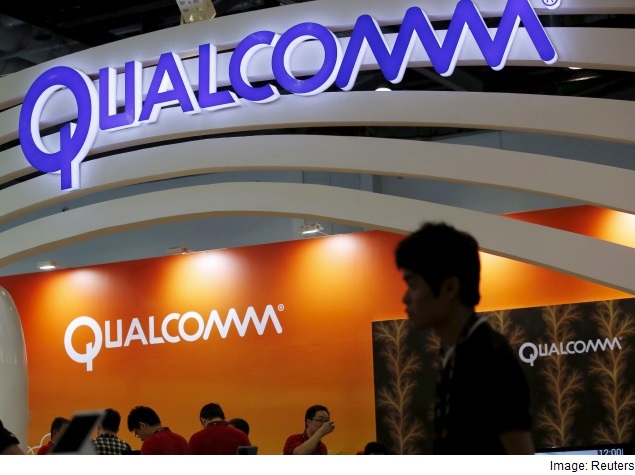- Home
- Mobiles
- Mobiles News
- Qualcomm in Venture With Chinese Chip Maker
Qualcomm in Venture With Chinese Chip Maker

The company, the Semiconductor Manufacturing International Corp., also known as SMIC, said on Tuesday that it would form a new company with a leading Belgian microelectronics research centre and Qualcomm, the American chip giant, to help it develop and produce new generations of advanced semiconductors that work as the brains of numerous electronics products, like smartphones and servers.
Four months ago, China imposed a $975 million fine on Qualcomm, saying it violated anti-monopoly law, and forced it to reduce sharply the licensing fees it charges Chinese smartphone makers for its communications chips.
While Qualcomm previously helped the Chinese company develop chips, the new deal involves far more advanced technology. The move will help Qualcomm use more companies to produce the chips it designs that power many of the world's most popular smartphones. The plan is also probably a tactic to improve relations with the Chinese government, according to analysts.
"Qualcomm just had a huge settlement with the Chinese government, so from their perspective they need to be able to sell in China," said Willy C. Shih, a professor of technology and operations management at Harvard Business School.
"The logic is if they help SMIC manufacture Qualcomm chips in China, that improves their ability to sell those chips there."
The new partnership, which also includes Huawei Technologies, the Chinese maker of telecommunications equipment, is also the most recent example of the chip multinational companies cooperating more closely with Chinese companies.
Intel, a rival of Qualcomm, last year agreed to invest $1.5 billion (roughly Rs. 9,549 crores) in Tsinghua Unigroup, a state-controlled company that has emerged from relative obscurity to become a sort of chip national champion. Also last year, IBM agreed to license to a local Chinese company advanced chip technology that works in servers.
That is a break from the approach of the last decade, when leading semiconductor makers refrained from establishing their most advanced research labs and production centres in China - largely to protect intellectual property, which in the industry often costs billions of dollars a year to generate.
"This really is Qualcomm playing nice with the Chinese government," said Mark Hung, a semiconductor analyst with Gartner, a market research company. Hung pointed to the earlier deal with SMIC to make chips, as well as the announcement last year of a $150 million (roughly Rs. 954 crores) fund to invest in Chinese companies, as other ways the company was trying to get on the government's good side, despite the antitrust troubles. "Throughout the investigation they tried to be better citizens," he said.
Jon Carvill, a Qualcomm spokesman, declined to provide any financial details about the deal, but described it as a "SMIC-led" venture. The manufacturing behind the new chip "is expected to have a long life cycle," Carvill said.
The deal could put pressure on some of Qualcomm's partners, like the Taiwan Semiconductor Manufacturing Co., a major chip maker that has long worked closely with Qualcomm to produce processors.
"TSMC may be a little leery of this," Hung said.
China has emerged as the world's largest smartphone market, giving it stronger bargaining power with companies that supply the parts that make those phones work. In working more closely with Chinese companies, foreign chip companies are also helping support a broader industrial policy through which Beijing hopes to expand chip research and production capacity within China, according to analysts.
"The Chinese government has been very persistent and insistent in their policies. They want local chip manufacturing there, and this is another leak in the dike. It's another part of the steady progress on their side," Shih said.
Chinese companies like SMIC have greatly lagged behind rivals like Samsung Electronics and Intel, partly because of export restrictions on the sophisticated tools and machines required to produce the most advanced chips. In 2013, China imported $232 billion worth of semiconductor materials, more than it spent on petroleum.
To close the gap, Beijing has pledged a huge amount of resources. Ma Kai, the vice premier and one of the country's top leaders, leads a task force created to make China's chip industry a global leader by 2030. The task force is estimated to have about $170 billion (roughly Rs. 10,82,225 crores) in government money to spend over the next decade, according to a report last year by McKinsey & Co.
Underlying the importance of the agreement, photos from an SMIC release showed that President Xi Jinping of China was present at the announcement of the agreement, which was made during an official visit to Beijing by King Philippe of Belgium.
Imec, the Belgian partner in the joint venture, is a well-known non-profit research institute that has helped pioneer techniques that help produce some of the world's smallest and most sophisticated chips. In an interview with the electronics industry publication EE Times that was published Tuesday, Luc Van den hove, Imec's chief executive, said that the company's investment in the deal would be "very, very small" and that Imec would support SMIC's production of the new generation of chips "very strictly following export controls."
The first stated goal of the new company is to help SMIC produce, by 2020, the generation of chips that some rivals are already producing. SMIC is now two generations behind, so that timeline would effectively help the Chinese company catch up by one generation of technology on global leaders like Intel, according to analysts.
"Money only gets you so far, it's really know-how," said Hung of Gartner. "In manufacturing, IMEC can provide some, Qualcomm and Huawei cannot."SMIC will also have the rights to license the intellectual property created by the new company, according to a statement released Tuesday.
© 2015 New York Times News Service
Catch the latest from the Consumer Electronics Show on Gadgets 360, at our CES 2026 hub.
Related Stories
- Samsung Galaxy Unpacked 2025
- ChatGPT
- Redmi Note 14 Pro+
- iPhone 16
- Apple Vision Pro
- Oneplus 12
- OnePlus Nord CE 3 Lite 5G
- iPhone 13
- Xiaomi 14 Pro
- Oppo Find N3
- Tecno Spark Go (2023)
- Realme V30
- Best Phones Under 25000
- Samsung Galaxy S24 Series
- Cryptocurrency
- iQoo 12
- Samsung Galaxy S24 Ultra
- Giottus
- Samsung Galaxy Z Flip 5
- Apple 'Scary Fast'
- Housefull 5
- GoPro Hero 12 Black Review
- Invincible Season 2
- JioGlass
- HD Ready TV
- Laptop Under 50000
- Smartwatch Under 10000
- Latest Mobile Phones
- Compare Phones
- Honor Win RT
- Honor Win
- Xiaomi 17 Ultra Leica Edition
- Xiaomi 17 Ultra
- Huawei Nova 15
- Huawei Nova 15 Pro
- Huawei Nova 15 Ultra
- OnePlus 15R
- Asus ProArt P16
- MacBook Pro 14-inch (M5, 2025)
- OPPO Pad Air 5
- Huawei MatePad 11.5 (2026)
- Xiaomi Watch 5
- Huawei Watch 10th Anniversary Edition
- Acerpure Nitro Z Series 100-inch QLED TV
- Samsung 43 Inch LED Ultra HD (4K) Smart TV (UA43UE81AFULXL)
- Asus ROG Ally
- Nintendo Switch Lite
- Haier 1.6 Ton 5 Star Inverter Split AC (HSU19G-MZAID5BN-INV)
- Haier 1.6 Ton 5 Star Inverter Split AC (HSU19G-MZAIM5BN-INV)

















